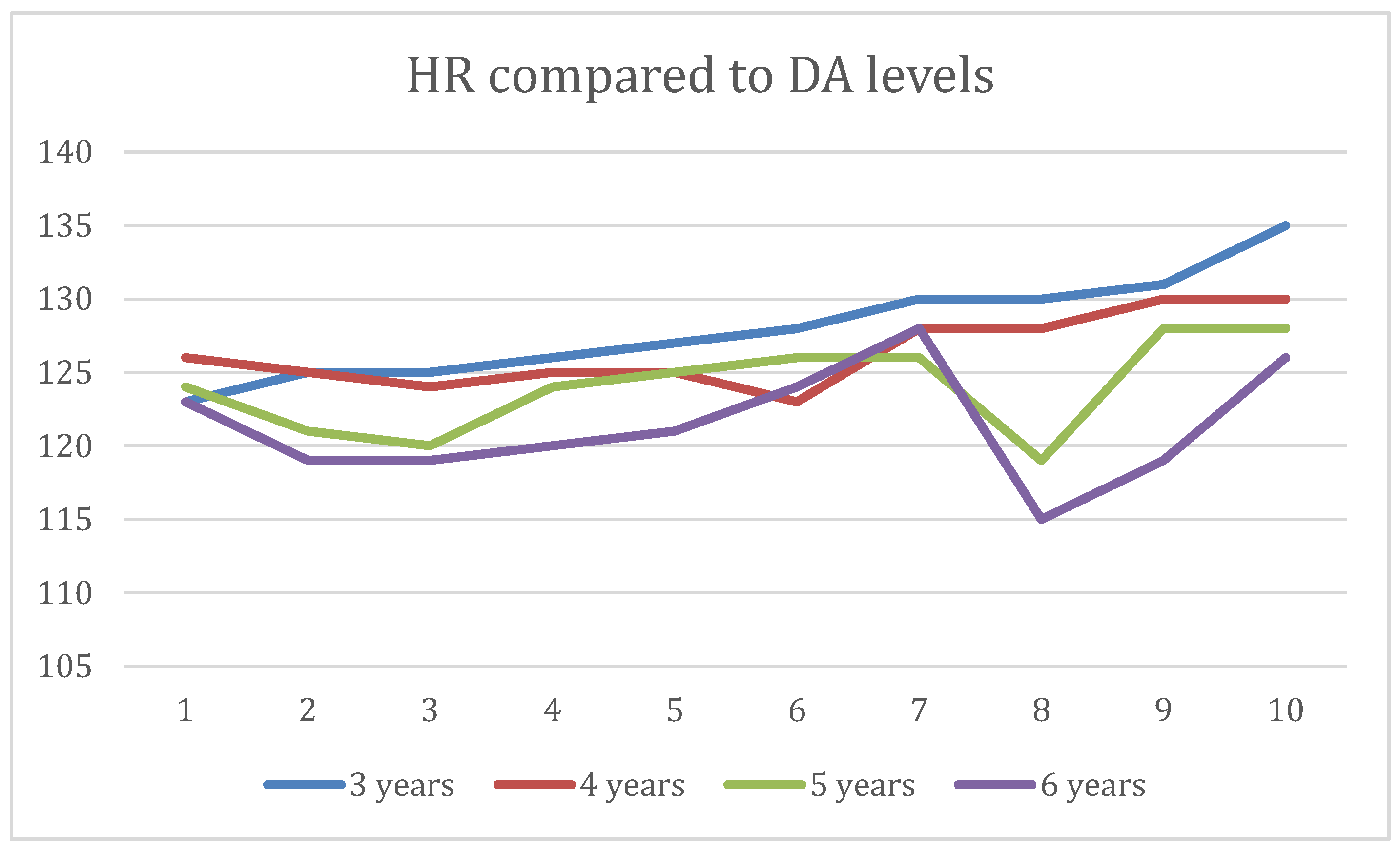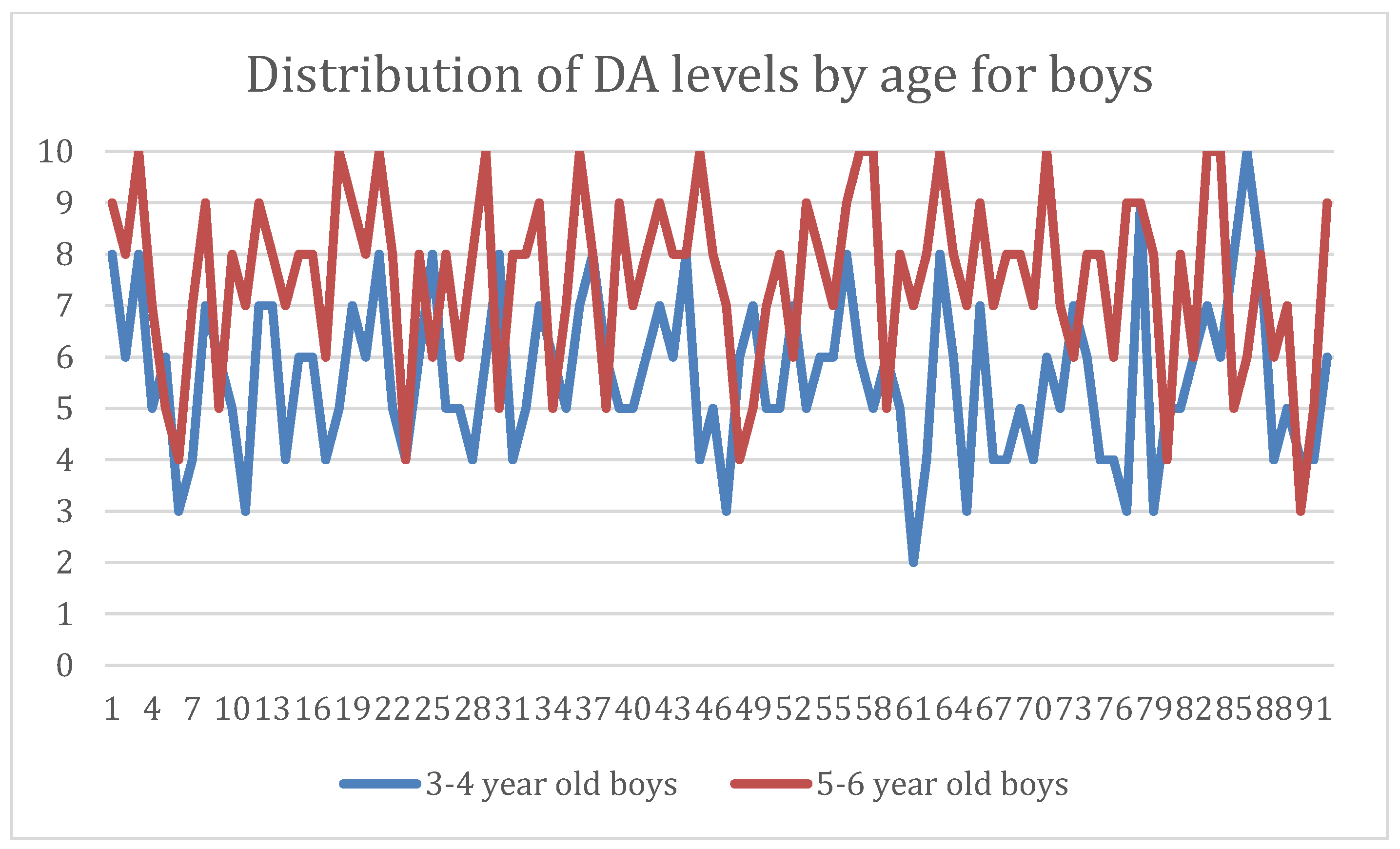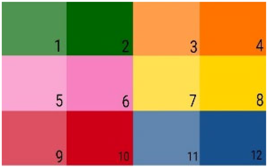Retrospective Study Regarding the Correlation between Dental Anxiety and Color Preferences in Children with Severe Early Childhood Caries
Abstract
1. Introduction
2. Materials and Methods
2.1. Study Design
2.2. Statistical Data Analysis
3. Results
4. Discussion
5. Conclusions
Author Contributions
Funding
Institutional Review Board Statement
Informed Consent Statement
Data Availability Statement
Conflicts of Interest
References
- Pitts, N.B.; Baez, R.J.; Diaz-Guillory, C.; Donly, K.J.; Alberto Feldens, C.; McGrath, C.; Phantumvanit, P.; Seow, W.K.; Sharkov, N.; Songpaisan, Y.; et al. Early Childhood Caries: IAPD Bangkok Declaration. Int. J. Paediatr. Dent. 2019, 86, 72. [Google Scholar]
- Leal, S.C.; Abreu, D.M.M.; Frencken, J.E. Dental anxiety and pain related to art. J. Appl. Oral Sci. Rev. 2009, 17, 84–88. [Google Scholar] [CrossRef]
- AAPD Policy on Early Childhood Caries (ECC). Classifications, Consequences, and Preventive Strategies. Pediatr. Dent. 2016, 38, 52–54. [Google Scholar]
- Taani, D.Q.; El-Qaderi, S.S.; Abu Alhaija, E.S. Dental anxiety in children and its relationship to dental caries and gingival condition. Int. J. Dent. Hyg. 2005, 3, 83–87. [Google Scholar] [CrossRef] [PubMed]
- Guentsch, A.; Stier, C.; Raschke, G.F.; Peisker, A.; Fahmy, M.D.; Kuepper, H.; Schueler, I. Oral health and dental anxiety in a German practice-based sample. Clin. Oral Investig. 2017, 21, 1675–1680. [Google Scholar] [CrossRef] [PubMed]
- Gustafsson, A. Dental behavior management problems among children and adolescents—A matter of understanding? Studies on dental fear, personal characteristics and psychosocial concomitants. Swed. Dent. J. Suppl. 2010, 202, 21–46. [Google Scholar]
- Kotsanos, N.; Sarnat, H.; Park, K. Pediatric Dentistry, 2nd ed.; Springer Nature: Cham, Switzerland, 2022; pp. 39–40. [Google Scholar]
- Klingberg, G. Broberg—Dental fear/anxiety and dental behavior management problems in children and adolescents: A review of prevalence and concomitant factors. Int. J. Paediatr. Dent. 2007, 17, 391–406. [Google Scholar] [CrossRef]
- Yildirim, T.T.; Dundar, S.; Bozoglan, A.; Karaman, T.; Karaman, N.; Kaya, F.A.; Altintas, E.; Oztekin, F.; Atas, O.; Alan, H. Is there a relation between dental anxiety, fear and general psychological status? PeerJ 2017, 5, e2978. [Google Scholar] [CrossRef]
- Duggal, M.; Cameron, A.; Toumba, J. Paediatric Dentistry at a Glance; Wiley-Blackwell: Oxford, UK, 2013. [Google Scholar]
- Asokan, A.; Kambalimath, H.V.; Patil, R.U.; Maran, S.; Bharath, K. A survey of the dentist attire and gender preferences in dentally anxious children. J. Indian Soc. Pedod. Prev. Dent. 2016, 34, 30. [Google Scholar] [CrossRef]
- Eastlake, C.L. (Ed.) Goethe. Effect of colors with reference to moral association. In Theory of Colors, 2nd ed.; MIT Press: Cambridge, MA, USA, 1840; pp. 321–329. [Google Scholar]
- Radhakrishna, S.; Srinivasan, I.; Setty, J.V.; Murali Krishna, D.R.; Melwani, A.; Hegde, K.M. Comparison of three behavior modification techniques for management of anxious children aged 4–8 years. J. Dent. Anesthsia Pain Med. 2019, 19, 29–36. [Google Scholar] [CrossRef]
- Rojas-Alcayaga, G.; Uribe, L.; Barahona, P.; Lipari, A.; Molina, Y.; Herrera, A.; Ríos, M. Dental experience, anxiety, and oral health in low-income chilean children. J. Dent. Child. 2015, 82, 141–146. [Google Scholar]
- Annamary, K.; Prathima, G.S.; Sajeev, R.; Kayalvizhi, G.; Ramesh, V.; Ezhumalai, G. Colour Preference to Emotions in Relation to the Anxiety Level among School Children in Puducherry—A Cross-Sectional Study. J. Clin. Diagn. Res. 2016, 10, ZC26-30. [Google Scholar] [CrossRef] [PubMed]
- Farhat-McHayleh, N.; Harfouche, A.; Souaid, P. Techniques for managing behaviour in pediatric dentistry: Comparative study of live modelling and tell-show-do based on children’s heart rates during treatment. J. Can. Dent. Assoc. 2009, 75, 283. [Google Scholar] [PubMed]
- De Menezes Abreu, D.M.; Leal, S.C.; Mulder, J.; Frencken, J.E. Patterns of dental anxiety in children after sequentialdental visits. Eur. Arch. Paediatr. Dent. 2011, 12, 298–302. [Google Scholar] [CrossRef] [PubMed]
- Dobrinka, M. Damyanova-Severe Early Childhood Caries—A Clinical Case Report. Arch. Dent. Oral Health 2019, 2, 11–17. [Google Scholar]
- Mendoza-Mendoza, A.; Perea, M.B.; Yañez-Vico, R.M.; Iglesias-Linares, A. Dental fear in children: The role of previous negative dental experiences. Clin. Oral Investig. 2015, 19, 745–751. [Google Scholar] [CrossRef]
- Beresescu, L.; Kovacs, M.; Vlasa, A.; Stoica, A.M.; Csilla, B.; Pop, M.; Bungardean, D.; Esian, D. Retention Ability of a Glass Carbomer Pit and Fissure Sealant. Int. J. Environ. Res. Public Health 2022, 19, 1966. [Google Scholar] [CrossRef]
- Farooq, I.; Ali, S. A cross sectional study of gender differences in dental anxiety prevailing in the students of a Pakistan dental college. Saudi J. Dent. Res. 2015, 6, 21–25. [Google Scholar] [CrossRef]
- Lima, D.; Barreto, K.A.; Rank, R.C.I.C.; Vilela, J.E.R.; Corrêa, M.S.N.P.; Colares, V. Does previous dental care experience make the child less anxious? An evaluation of anxiety and fear pf pain. Eur. Arch. Paediatr. Dent. 2021, 22, 139–143. [Google Scholar] [CrossRef] [PubMed]
- Rodd, H.; Timms, L.; Noble, F.; Bux, S.; Porritt, J.; Marshman, Z. Message to dentist: Facilitating communication with dentally anxious children. Dent. J. 2019, 7, 69. [Google Scholar] [CrossRef]
- Vlad, R.; Pop, A.M.; Olah, P.; Monea, M. The evaluation of dental anxiety in primary school children: A cross-sectional study from Romania. Children 2020, 7, 158. [Google Scholar] [CrossRef] [PubMed]
- Al-Namankany, A.; Ashley, P.; Petrie, A. Development of the first Arabic cognitive dental anxiety scale for children and young adults. World J. Meta-Anal. 2014, 2, 64–70. [Google Scholar] [CrossRef]
- Yeung, S.P.; Wang, I.W. Gender labels on gender- neutral colors: Do they affect children’s color preferences and play performance? Sex Roles 2018, 79, 260–272. [Google Scholar] [CrossRef]
- Koch, G.; Poulsen, S.; Espelid, I.; Haubek, D. Pediatric Dentistry. In A Clinical Approach, 3rd ed.; Wiley-Blackwell: Hoboken, NJ, USA, 2017; pp. 19–20. [Google Scholar]
- Eshaghabadi, A.; Koulivand, P.H.; Kazemi, H. Color psychology and its effect on hospital design and patient treatment. Neurosci. J. Shefaye Khatam 2017, 5, 130–142. [Google Scholar] [CrossRef][Green Version]
- Bubna, K.; Hegde, S.; Rao, D. Role of colors in pediatric dental practices. J. Clin. Pediatr. Dent. 2017, 41, 193–198. [Google Scholar] [CrossRef] [PubMed]
- Umamaheshwari, N.; Asokan, S.; Kumaran, T.S. Child friendly colors in a pediatric dental practice. J. Indian Soc. Pedod. Prev. Dent. 2013, 31, 225–228. [Google Scholar] [CrossRef]
- Dalai, J.; Vikesh, S. Colors and Flavors: Adding Joy to Pediatric Dentistry—A cross-sectional study. J. Contemp. Dent. 2018, 8, 63–69. [Google Scholar] [CrossRef]
- Sujatha, P.; Nara, A.; Avanti, A.; Shetty, P.; Anandakrishna, L.; Patil, K. Child Dental Patient’s Anxiety and Preference for Dentist’s Attire: A cross sectional study. Int. J. Clin. Pediatr. Dent. 2021, 14, S107. [Google Scholar]
- Fagundes, N.C.F.; Minervini, G.; Furio Alonso, B.; Nucci, L.; Grassia, V.; d’Apuzzo, F.; Puigdollers, A.; Perillo, L.; Flores-Mir, C. Patient-reported outcomes while managing obstructive sleep apnea with oral appliances: A scoping review. J. Evid. Based Dent. Pract. 2023, 23, 101786. [Google Scholar] [CrossRef] [PubMed]



| Color Number | The Name of the Color | RGB Code |
|---|---|---|
| 1 | Light Deep Green | (79, 148, 81) |
| 2 | Deep Green | (0, 102, 2) |
| 3 | Light Philippines Orange | (255, 158, 75) |
| 4 | Philippines Orange | (255, 116, 0) |
| 5 | Light Persian Pink | (249, 167, 210) |
| 6 | Persian Pink | (247, 128, 191) |
| 7 | Light Absolute Yellow | (255, 224, 82) |
| 8 | Absolute Yellow | (255, 211, 2) |
| 9 | Light Chinese Red | (211, 80, 97) |
| 10 | Chinese Red | (206, 1, 24) |
| 11 | Light Porcelain Blue | (97, 134, 176) |
| 12 | Porcelain Blue | (24, 81, 141) |

| Age Group | Number of Subjects | Girls | Boys | Total |
|---|---|---|---|---|
| 3–4 years of age | N (%) | 18 (56.25) | 14 (43.75) | 32 (35) |
| 5–6 years of age | N (%) | 27 (47.76) | 32 (54.23) | 59 (65) |
| 3-Year-Old Subjects | Girls | Boys | ||||
|---|---|---|---|---|---|---|
| Color | % | Color | % | Color | % | |
| Happiness | 6 | 27 | 6 | 37 | 7 | 27 |
| Anxiety | 12 | 27 | 12 | 37 | 10, 11 | 18 |
| Dentist’s scrubs | 6 | 23 | 6 | 37 | 12 | 27 |
| Dental chair | 6 | 37 | 6 | 58 | 4 | 36 |
| Mask | 6 | 30 | 6 | 42 | 3 | 18 |
| Walls | 5 | 27 | 5 | 32 | 5, 7 | 18 |
| Medical cap | 6 | 27 | 6 | 37 | 3, 4 | 18 |
| 4-Year-Old Subjects | Girls | Boys | ||||
|---|---|---|---|---|---|---|
| Color | % | Color | % | Color | % | |
| Happiness | 7 | 29 | 7 | 27 | 7 | 30 |
| Anxiety | 12 | 33 | 12 | 55 | 9, 10 | 30 |
| Dentist’s scrubs | 5 | 29 | 5 | 45 | 2 | 30 |
| Dental chair | 6 | 23 | 5 | 55 | 12 | 30 |
| Mask | 2 | 23 | 5, 6 | 27 | 2 | 50 |
| Walls | 7 | 38 | 5 | 45 | 7 | 50 |
| Medical cap | 5 | 29 | 5 | 45 | 2 | 50 |
| 5-Year-Old Subjects | Girls | Boys | |||
|---|---|---|---|---|---|
| Color | % | Color | % | ||
| Happiness | 7 | 36 | - | 7 | 45 |
| Anxiety | 10 | 43 | - | 10 | 45 |
| Dentist’s scrubs | 10 | 29 | - | 10 | 36 |
| Dental chair | 10, 11 | 21 | - | 10, 11 | 27 |
| Mask | 10, 11 | 21 | - | 10, 11 | 27 |
| Walls | 7 | 43 | - | 7 | 45 |
| Medical cap | 11 | 29 | - | 11 | 36 |
| 6-Year-Old Subjects | Girls | Boys | ||||
|---|---|---|---|---|---|---|
| Color | % | Color | % | Color | % | |
| Happiness | 6 | 31 | 6 | 53 | 10 | 28 |
| Anxiety | 12 | 17 | 2 | 29 | 3, 4, 10, 12 | 17 |
| Dentist’s scrubs | 5 | 23 | 5 | 35 | 1, 10 | 33 |
| Dental chair | 5, 11 | 23 | 5 | 35 | 11 | 44 |
| Mask | 5 | 29 | 5 | 47 | 11, 12 | 22 |
| Walls | 5 | 29 | 5 | 35 | 11 | 22 |
| Medical cap | 5 | 17 | 5 | 24 | 1 | 28 |
Disclaimer/Publisher’s Note: The statements, opinions and data contained in all publications are solely those of the individual author(s) and contributor(s) and not of MDPI and/or the editor(s). MDPI and/or the editor(s) disclaim responsibility for any injury to people or property resulting from any ideas, methods, instructions or products referred to in the content. |
© 2024 by the authors. Licensee MDPI, Basel, Switzerland. This article is an open access article distributed under the terms and conditions of the Creative Commons Attribution (CC BY) license (https://creativecommons.org/licenses/by/4.0/).
Share and Cite
Esian, D.; Bica, C.; Vlasa, A.; Bud, E.; Stepco, E.; Bud, A.; Beresescu, L. Retrospective Study Regarding the Correlation between Dental Anxiety and Color Preferences in Children with Severe Early Childhood Caries. Dent. J. 2024, 12, 155. https://doi.org/10.3390/dj12060155
Esian D, Bica C, Vlasa A, Bud E, Stepco E, Bud A, Beresescu L. Retrospective Study Regarding the Correlation between Dental Anxiety and Color Preferences in Children with Severe Early Childhood Caries. Dentistry Journal. 2024; 12(6):155. https://doi.org/10.3390/dj12060155
Chicago/Turabian StyleEsian, Daniela, Cristina Bica, Alexandru Vlasa, Eugen Bud, Elena Stepco, Anamaria Bud, and Liana Beresescu. 2024. "Retrospective Study Regarding the Correlation between Dental Anxiety and Color Preferences in Children with Severe Early Childhood Caries" Dentistry Journal 12, no. 6: 155. https://doi.org/10.3390/dj12060155
APA StyleEsian, D., Bica, C., Vlasa, A., Bud, E., Stepco, E., Bud, A., & Beresescu, L. (2024). Retrospective Study Regarding the Correlation between Dental Anxiety and Color Preferences in Children with Severe Early Childhood Caries. Dentistry Journal, 12(6), 155. https://doi.org/10.3390/dj12060155







